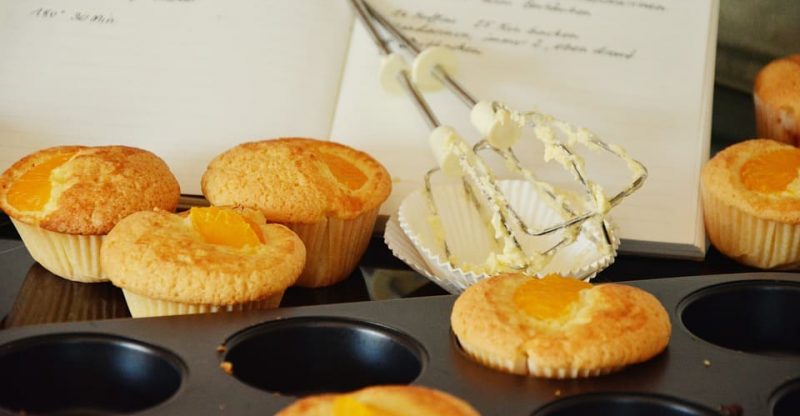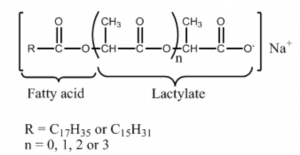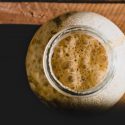What is Sodium Stearoyl Lactylate (E481) in Food & is SSL Vegan?

Production | Components | Uses | Safety | Side effects | FAQs
Sodium stearoyl lactylate or Sodium stearoyl-2-lactylate, also known as SSL (abbreviation), it is the sodium salt of stearic acid with lactic acid dimer. This ingredient is commonly used as an emulsifier and stabilizer in high-fat bakery and with the European food additive number E481.
Together with calcium stearoyl lactylate (E482), they are the second category (lactylates) of popular emulsifier after mono- and diglycerides of fatty acids in food applications.
How is Sodium Stearoyl Lactylate made?
SSL is synthesized from food-grade stearic acid (mostly from palm oil), lactic acid (from the fermentation of sugar beet or chemical synthesis) and sodium hydroxide.
There are two manufacturing processes of producing SSL based on the reaction sequence.
The FDA mentioned that SSL can be produced by the esterification of stearic acid and lactic acid to form stearoyl lactylic acid and then neutralized into the sodium salt with sodium hydroxide. (1)
The information from the EFSA is the neutralization first and then the esterification (2). The brief manufacturing process as follows:
- Mixture: mix aqueous stearic acid (control the temperature above its solidification point) with aqueous lactic acid
- Neutralization: add sodium hydroxide to the mixture and the neutralization reaction will take place between sodium hydroxide and lactic acid
- Esterification
SSL is hygroscopic and will become sticky in moist air. So sometimes SSL powder is blended with an anti-caking agent (e.g. calcium carbonate) to make it not sticky and free-flowing.
What is Sodium Stearoyl Lactylate made of?
SSL is a mixture and the impurities are brought from raw materials or generated in the production as the reaction is complicated.
It’s three major components as follows:
- Sodium stearoyl-2-lactylate
- Sodium stearoyl-1-lactylate
- Sodium palmitoyl-1-lactylate (comes from the reaction of palmitic acid, lactic acid and sodium hydroxide. Commercial stearic acid made from vegetable oils commonly contain palmitic acid)
That’s resulting in the structure of SSL can be written as below:

Image Source
SSL may also contain the following impurities:
- Palmitoyl lactylic acid
- Stearoyl lactylic acid
- Free fatty acids (palmitic acid and stearic acid)
- Free lactic acid
- Salts of fatty acid esters of lactic acid
- Salts of fatty acid esters of polymerized lactic acid
Specification
| Other Names |
|
| CAS Number | 25383-99-7 |
| Chemical formula | C24H43NaO6 |
| Molecular Weight | 450.592 |
| Melting Point | 49 °C (120 °F; 322 K) |
Properties
Appearance
A waxy white or slightly yellowish powder or brittle solid (flake) with a slightly acidic smell.
Structure

Image Source
- Lipophilic group: the long-chain stearoyl group
- Hydrophilic group: the carbonium ion of lactic acid
HLB
10-12, gives oil-in-water emulsions, O/W, SSL also functions as a humectant.
Solubility
In water
Insoluble in water, disperse in hot water. With a poor water solubility at low temperature although it is a hydrophilic emulsifier, and therefore heat treatment of water is needed before the use of SSL.
In organic solvents
Soluble in ethanol, hot edible oils and fats.
What’re the Uses of Sodium Stearoyl Lactylate?
Sodium stearoyl lactylate is primarily used for its emulsifying and stabilizing properties in food and cosmetics. In food, SSL mixes water and oil together and mostly used as a dough strengthener and crumb softener in bakery; in cosmetics, it is a viscosity enhancer and conditioner.
Food
SSL is mainly used in high fat & yeast-leavened bread as a dough conditioner/emulsifier for the purposes of:
- dough strengthening: increase volume and obtain a better crumb structure
- crumb softening: interacts with flour to form gluten proteins/starch/lactylate complex which produce a soft and elastic bread and prevents bread retrogradation (aging)
If without SSL, the loaf will become hardened.
It is also used in cookies, crackers, pastries, noodles, and the like to improve the texture, mouthfeel and prolong the freshness or shelf time. In cookie and cracker, SSL is used to distribute shortening uniformly in the dough.
SSL can be directly added to flour or dispersed in warm water and then blended with flour for use.
Other food may contain with SSL:
- Whipped toppings and desserts (an aerating agent)
- Non-dairy coffee creamers (a complexing agent stable the emulsion)
- Whitening powder ( a fat replacer)
- Spreads
Cosmetics
Sodium stearoyl lactylate is used as an emulsifying agent (3) to stabilize oil-in-water formulations of cosmetics and personal care products.
SSL may be found in the following cosmetics:
- Skin care products
- Shampoo
- Lotion
Is Sodium Stearoyl Lactylate Safe to Eat?
Yes, it has been approved as a safe ingredient by the U.S. Food and Drug Administration (FDA) and the European Food Safety Authority (EFSA), as well as Joint FAO/WHO Expert Committee on Food Additives (JECFA).
FDA
FDA has approved SSL as a direct multifunctional food additive that can be used as an emulsifier, stabilizer, surface-active agent in the following food categories with the maximum usage (4):
- Baked products, pancakes, and waffles 0.5%
- Icings, fillings, puddings, and toppings 0.2%
- Beverage coffee as substitutes for milk or cream 0.3%
- Dehydrated potatoes 0.5%
- Snack dips 0.2%
- Cheese substitutes and imitations 0.2%
- Sauces or gravies 0.25%
- Cream liqueur drinks 0.5%
EFSA
Sodium stearoyl lactylate (E481) is listed in Commission Regulation (EU) No 231/2012 as an authorised food additive and categorized in “Additives other than colours and sweeteners” (5).
Approved uses
Its application is listed together with calcium stearoyl lactylate (E482) with the maximum permitted levels (MPLs) from 1000 to 10000 mg/kg in foods. The following food may contain it (6):
- Flavoured fermented milk products
- Beverage whiteners
- Fat and oil emulsions
- Mostarda difrutta
- Sugar confectionery
- Chewing gum
- Desserts, decorations, coatings and fillings
- Breakfast cereals
- Quick-cook rice
- Bread and rolls
- Fine bakery wares
- Minced and diced canned meat products
Safety re-evaluation in 2013
After the studies of reproductive toxicity, carcinogenicity, genotoxicity and others, EFSA stated that an ADI of 22 mg/kg bw/day for sodium stearoyl-2-lactylate (E481) separately or in combination with calcium stearoyl-2-lactylate (E 482) can be established. (7)
UK Food Standards Agency
Categorized in “Others” (8)
Food Standards Australia New Zealand
It is an approved ingredient in Australia and New Zealand with the code number 481. (9)
JECFA
Function Class: food additives, emulsifier, stabilizer. (10)
Acceptable daily intake: ADI “20mg/kg bw” set in 1973. (11)
What’re the Possible Side Effects of Sodium Stearoyl Lactylate?
There is no observed adverse effect but may cause allergy. In 2005, a case of SSL contact allergy symptoms – dermatitis and rhinitis were reported in a manicurist who had been making artificial acrylic nails. (12)
Frequently Asked Questions
Is SSL Dairy Origin?
No, SSL is not derived from dairy and does not contain lactose (13) and casein. So it is generally safe for people with lactose intolerant and milk allergy.
When consumers come up with this question, it usually refers to lactic acid which is the main raw material employed in the manufacturing of sodium stearoyl lactylate. As mentioned above, lactic acid is usually obtained from the fermentation of carbohydrates or chemical synthesis and has nothing to do with dairy, although the name lact- coming from the Latin word lac, which means milk.
Is SSL Vegan?
Yes, sodium stearoyl lactylate is vegan if stearic acid is originated from vegetables so that it can be added into the diet of vegetarians.
SSL is made from the reaction among lactic acid, stearic acid and sodium hydroxide. Whether it is vegan or not depending on the sources of these three ingredients.
- Lactic acid (E270): vegan as made from the fermentation of sugar (L form) or synthesized from petrochemical sources (Racemic DL form).
- Sodium hydroxide: vegan, originated from the mineral source.
- Stearic acid: a saturated fatty acid naturally found in animal fats & oils and vegetable oils. Vegetable sources such as palm oil, coconut oil, rapeseed oil and soybean oil. It can also be sourced from animals. Today, the vegetable sources are mostly occupied for producing food grade stearic acid.
Is SSL Natural?
It is not natural as it is made from chemical synthesis although the raw materials stearic acid and lactic acid are natural.
Is SSL Halal?
Yes, SSL would be halal if the fatty acid stearic acid is sourced from vegetables.
What are the different uses between Glycerol monostearate (GMS) and SSL?
GMS and SSL are both emulsifiers used in bakeries to extend the shelf life but with the different types of bakery applied.
GMS is usually used in baked goods with high moisture while SSL is added in bakery products with high fat content.
Conclusion
Now you may have a good knowledge of the emulsifier – Sodium stearoyl lactylate (E481), from the following aspects:
- Production process
- What is it made of
- Main uses in baked goods
- Safety
- Possible side effects
- FAQs: vegan, dairy free, synthetic, comparison with GMS.
If you have any questions or remarks about this additive, feel free to let me know in the comments.



Useful information for my work application.
Thanks!
Maida namkin crispy kaise karen
Very useful article. It has answers to many of the questions I have had lately. I thank you. I am a home baker, I’m always trying to improve my baking in order to start a baking business from home, so, recently, I have purchased SSL and GMS. But, I am wondering now, can I use both, together, in my cakes? Can I add Soy Lecithin to them, too? And If so, how much can I add, say for a 100g of cake flour I’m using? I am not good in maths anymore, I apologise, so how to calculate the percentage of those additives to the weight of flour in a cake recipe? Thank you so much in advance and thank you again for the much helpful article.
Is it a Trans fat?
i have a question, regarding Wiped cream powder, i have added ssl in non dairy creamer and hot form and i can wiped it, but in chilled water i cant and the cream has a soft emulsion but i cant get it in cold water, please suggest me the how can i make it a proper whipped cream powder